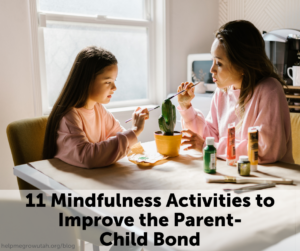
When in stressful situations, it can be common for parents to have “knee-jerk” reactions. We may lash out at our children, raise our voices, or become irrationally upset about little things. Some parents will even resort to what was modeled in their own childhood when in the heat of the moment. These reactions can lead to strain on the parent-child relationship. So how do we react better when faced with stressful situations?
First, we can slow things down by breathing through the stress. Taking a second to breathe can calm our mind and body, take ourselves out of fight or flight, and give more clarity to the situation. We can respond rather than simply react.
We can also build mindfulness activities into our daily routines and interactions with our children. This can foster these positive coping skills so we are ready when stressful situations arise. Not only is it beneficial for our well-being as parents but it can also strengthen the bond between parents and children.
Here are a few ideas:
0-6 Months
Infant Massage: Massage baby’s arms and legs with baby-safe oil. This can help to build connections and calm both you and your baby.
Breathing Together: Lay baby on your chest or nestle your child into your side. Focus on your breathing and your child’s breathing. Is it fast? Slow? Does it change pace? Are you in sync or do you have two separate rhythms?
6-12 Months
Gaze Following: Follow your child’s gaze. What are they looking at? Focus on your child without distracting them. What is keeping their attention? Make comments if it feels right.
Fun with Food: Eat a favorite snack or treat together or make art with food. Focus on what you are feeling and experiencing. What do you taste? What face is your baby making? Are they taking small or big bites? Make eye contact with your baby and have fun.
1 – 2 Years Old
Follow Their Lead: Engage in your child’s play but let them lead. Do they grab your hand to show you something? Place toys in your hand? What are they trying to share with you? Take time to be in the moment with them.
2 – 3 Years Old
Mindful Touch: Use different soft objects to stroke your child’s arms, legs, back, or face. You can use feathers, puffballs, a soft blanket, etc. How do they react? Does it tickle? Do they prefer certain textures? Do you see signs they enjoy it? Switch places if able and let them try the different objects on your arms, legs, and face.
Musical Movements: Play a favorite song. Watch how your little one reacts. Do they like the music loud or soft? Is there a song they like more than others? Do they move around or just observe?
3 – 5 Years Old
Mindfulness Meditation: For preschool or older children, incorporate meditation into your daily routine or when you have downtime. This can include during a lull in your day when you are waiting, or during a time when stresses arise. Use a video or come up with your own. This will take practice so be patient and consistent.
Mindful Art: Make art with your child. You can paint, color, make a glitter jar, squish Play-Doh, use a sensory bin or take photographs. What does your child notice? Do they hear the sounds the crayons make? How does the Play-Doh feel on their hands? What does the glitter jar do when you shake it?
Connect with Nature: When at the park or in the mountains, ask what your child is noticing. Do they feel the wind? Hear the snow crunch? Smell the grass? See the dog catch the frisbee?
Nature Art: Collect leaves and rocks for later crafts like a nature paintbrush, leaf art, or painting rocks. Try animal yoga. Watch dogs or squirrels play in the park. Get boots out and stomp in rain puddles. Build a snowman. Find a mud puddle and let them explore.
Each of these ideas will help you and your child explore mindfulness and increase your bond throughout their ever-changing development.
Information Gathered from The Children’s Center webinar “Mindfulness with the Parent-Child Dyad”





